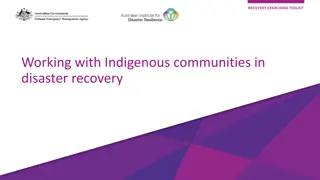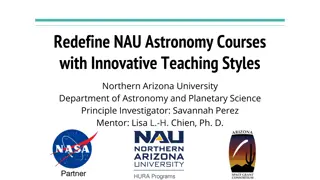Exploring Indigenous Soundscapes in Southeast Asian Music Education
The discussion revolves around the components of indigenous Soundscapes and their significance in shaping musicking indigeneity in music education across Southeast Asia. It delves into how porous transnational socio-cultural-religious networks can transcend political boundaries, enabling diverse forms of musicking indigeneity to thrive. Challenges and opportunities in leveraging Southeast Asian Indigenous Soundscapes as a unique resource are explored, emphasizing the importance of creating authentic musical forms unique to the region.
Download Presentation

Please find below an Image/Link to download the presentation.
The content on the website is provided AS IS for your information and personal use only. It may not be sold, licensed, or shared on other websites without obtaining consent from the author. Download presentation by click this link. If you encounter any issues during the download, it is possible that the publisher has removed the file from their server.
E N D
Presentation Transcript
Connecting Across Borders Southeast Asia Directors of Music Congress 2018 Southeast Asia Directors of Music Congress 2018 15-17 March 2018 Southeast Asian Music Museum @ College of Music, Mahidol University, Nakhon Pathom, Thailand Mohd Anis Md Nor Musicking Indigeneity: Connecting Southeast Asian Indigenous Soundscapes Across Borders Through Music Education Musicking activities which involve performing, listening, rehearsing, composing and participating performatively in music performance are products of indigenous Soundscapes that are biophony (collective habitat expression); geophony (sounds of natural elements) and anthropophony (environmental sounds created by humans) closely associated with ancestral territories and indigenous resources. Indigenous Soundscape, a component of the acoustic environment ranging from urban design to wildlife ecology, plays an important role in creating musicking indigeneity in Southeast Asia. Boundary delimitation by political entities or sovereign states does not prevent musicking indigeneity to transcend cultural and political divisions through porous transnational socio-cultural- religious networks. Crossing borders through socio-cultural-religious agencies in Mainland and Insular Southeast Asia have contributed distinct variants of musicking indigeneity in Southeast Asian music education from former temples and palaces to contemporary music schools. A combination of all the acoustic resources within a given Soundscape ranging from natural to human-caused sounds modified by the indigenous socio-cultural-religious environment have afforded the creation or re-creation of presentational or re-presentational musical forms for musicking indigeneity in music education in Southeast Asia.
Questions I am particularly interested in indigenous Soundscapes as products of musicking activities in Southeast Asia What are the components of indigenous Soundscapes and how they play an important role in creating musicking indigeneity in music education in Southeast Asia Would boundary delineation (political) prevent musicking indigeneity to transcend political and cultural divisions or on the other hand, could porous transnational socio-cultural-religious networks outstrip such boundaries? Could socio-cultural-religious networks as agencies exceed border cloisters enabling cross border variants of musicking indigeneity to permeate in Southeast Asian music education? How not to let this platform become another 'political' clich ? What are the challenges? What are the opportunities? Could I suggest that we look at Southeast Asian Indigenous Soundscapes as our pool of resources for musicking indigeneity rather than copying and pasting from precedence that are non-conventional to Southeast Asia? Hence, could a combination of all the acoustic resources within a given Soundscape ranging from natural to human-caused sounds modified by the indigenous socio-cultural-religious environment afforded the creation or re-creation of presentational or re-presentational musical forms for musicking indigeneity in music education in Southeast Asia?
Musicking (ref: Small, Christopher (1998) Musicking: The Meanings of Performing and Listening (Music/Culture). Wesleyan University Press. Christopher Small asserts that music is not a thing, but rather an activity. Musicking," a verb that encompasses all musical activity from composing to performing to listening to a Walkman to singing in the shower. Involves performing, listening, rehearsing, composing and participating performatively in music performance Using Gregory Bateson's philosophy of mind and a Geertzian thick description of how musicking forms a ritual through which all the participants explore and celebrate the relationships that constitute their social identity via music and music making I would suggest that Musicking Indigeneity is a product of indigenous Soundscapes that are biophony (collective habitat expression); geophony (sounds of natural elements) and anthropophony (environmental sounds created by humans) that are closely associated with ancestral territories and indigenous resources Musicking indigeneity in Southeast Asia indulges indigenous Soundscape, as a component of the acoustic environment from urban design to wildlife ecology
Indigenous Soundscapes A soundscape is a sound or combination of sounds that forms or arises from an immersive environment. The study of soundscape is the subject of acoustic ecology or soundscape ecology. Acoustic ecology, sometimes called ecoacoustics or soundscape studies, is a discipline studying the relationship, mediated through sound, between human beings and their environment. The idea of soundscape refers to both the natural acoustic environment, consisting of natural sounds, including animal vocalizations, the collective habitat expression of which is now referred to as the biophony, the sounds of weather and other natural elements, referred to as the geophony; and environmental sounds created by humans i.e. anthropophony through a sub-set called controlled sound, such as musical composition, sound design, and language, work, and sounds of mechanical origin resulting from use of industrial technology. The term soundscape also includes the listener's perception of sounds heard as an environment or an audio recording or performance of sounds that create the sensation of experiencing a particular acoustic environment, or compositions created using the found sounds of an acoustic environment, either exclusively or in conjunction with musical performances.
Indigeneity Definition accepted in 1972 by the UN Working Group for Indigenous Peoples, later amended in 1983. Composed of the existing descendants of the peoples who inhabited the present territory of a country wholly or partially at the time when persons of a different culture or ethnic origin arrived there from other parts of the world, overcame them, by conquest, settlement or other means, reduced them to a non-dominant or colonial condition; who today live more in conformity with their particular social, economic and cultural customs and traditions than with the institutions of the country of which they now form part, under a state structure which incorporates mainly national, social and cultural characteristics of other segments of the population which are predominant.
Discourses of Musicking Indigeneity Pre-Colonial SEA (Mainland and Insular SEAsia) Sacred/Temple Music, Royal/Palace/Classical Music, Popular Music etc. Dichotomous discourse between autochthonous (native to the place where they it is found) and/or allochthonous (originating in a place other than where it is found) musical affecting pre and post colonial music and music education in place of worships, royal palaces and indigenous community centers Multiple level negotiations by stakeholders of indigenous soundscapes and musicking-communitas - presentations Post-Colonial inventions and/or re-presentations
Crossing Borders Circumventing Conventions Socio-Cultural-Religious Agencies as crucibles of musicking indigeneity in Southeast Asia Variants of musicking indigeneity in Southeast Asian music education from former temples and palaces to contemporary music schools Acoustic environment combination of all resources within natural found sounds (biophony-geophony) and anthropophony; temple, mosques and churches anthropophony; twice-behave organized sounds musical composition. Musicking indigeneity in mainland and insular Southeast Asia linguistic groupings (Austroasiatic and Austronesian Soundscapes Ecology)
Link between Thai and Western Music: Prasid Prasid Silapabanleng Silapabanleng The son of Thai classical maestro Luang Pradit Phairoh (Sorn Silapabanleng, 1881-1954), Prasidh initially trained as a pianist before studying Western music composition at a university in Japan. Prasidh grew up at a time when Thai classical music was at its peak, before hitting a low during the 1940s as a result of the Pibulsongkram government's pro-West policy. The turning point came when Prasidh was commitment to Western music after he met Klaus Pringsheim, a student of Gustav Mahler in Japan, the composer who was then teaching at the Imperial Academy of Music, Geidai University. He worked as conductor for the Fine Arts Department's symphony orchestra and as composer, and he had a big hand in the formation of the department's Western music division. Prasidh's symphonic masterpieces include Siang Tian, Damnoen Sigh, Siamese Suite, and Cherd Nai, all adaptations of Luang Pradit Phairoh's original works. (The photo to the right shows the young Prasidh with teacher and mentor, Klaus Pringsheim)
Ki Nartosabdho Ki Nartosabdho "New creations are like noodles, which are not everyday foods. One day we will again eat rice. Or like beefsteak. God created the cow, the processing is up to us. " Famous composer of Javanese gending (specific class of colotomic structures used in Javanese gamelan music) Kreasi baru itu ibarat bakmi, yang bukan makanan sehari-hari. Suatu saat kita toh akan kembali makan nasi. Atau ibarat bistik. Tuhan menciptakan sapi, pengolahannya terserah kepada kita. Ki Nartosabdo's real name is Soenarto. Is the son of a keris sarong craftsman named Partinoyo. Difficult childhood makes Soenarto dropped out of school in formal education, namely Standaard School Muhammadiyah or SD 5 years. The difficult economic life makes Soenarto work to help the family income through his artistic talent. Among other things he once became a painter, as well as a violinist in the keroncong orchestra Sinar Purnama. The artistic talent grew when Sunarto was able to continue his studies at the Catholic Institute of Education. In 1945 Soenarto became acquainted with the founder of Wayang Orang Ngesti Pandowo group, Ki Sastrosabdo. Since then he has begun to know the world of puppetry where Ki Sastrosabdo is his teacher. Ki Narto is also known as the creator of highly productive Javanese songs. Through a karawitan group called Condong Raos that he founded, he composed 319 titles of songs (lelagon) or gendhing, such as Caping Mount, Gambang Suling, Mother Earth, Klinci Ucul, Prahu Layar, Ngundhuh Kite, Aja Dipl roki, and Rujak Jeruk.
Poignant Points of Reference of 20th Century Indigenous Musicking Link between Thai and Western Music i.e. Luang Pradit Phairoh (born as Sorn Silapabanleng) to Prasidh Silapabanleng (son of Luang Pradit Phairoh) i.e. King Rama VII and Queen Rambhai Bani to Pibulsongkram government's pro-West policy - Prasidh played an instrumental role in transforming a series of Thai classical songs into modern versions: Creation of Dramatic Colleges, University Fine Arts & Music Departments Cambodia: Royal University of Fine Arts - Its origins date to the establishment of the cole des arts cambodgiens in Phnom Penh in 1917. The school was closed after the establishment of the Khmers rouges r gime in 1975; it was re-opened in 1980. Ki Nartosabdho created Javanese gending (specific class of colotomic structures) - choose the best technique from some of the leading dalang, staged more carangan stories or wayang plays out of the standard (standard) path of the Mahabharata or Ramayana story while keeping the cast and the places in the Puppet Wayang Purwa figures based on Mahabharata or Ramayana - the outcome of deep appreciation of a standard story, or a new composition sourced from pakem (parent story). Indonesian experience: ASKI (Akademi Seni Karawitan), ASTI (Akademi Seni Tari, ASRI (Akademi Seni Rupa); ISI (Institut Seni Indonesia) morphing to ISBI (Institut Seni Budaya Indonesia) and STSI (Sekolah Tinggi Seni Indonesia) Philippines: PHSA (Philippine High School for the Arts) 1978 to date, located in the National Arts Center in Mount Makiling, Los Ba os, Laguna. UP School of Music etc. Singapore: SOTA (School of the Arts), La Salle, NAFA and YSTCM (Yong Siew Toh Conservatory of Music) Malaysia: ASKI-ASWARA (National Arts Academy) and Universities
Recap SEAsian Indigenous Soundscapes Malay-Indonesian adage Alam Terkembang Menjadi Guru and in Tagalog Ang Mundo ay Ang Iyong Guro i.e. The World is your Oyster biophonic, geophonic, anthropophonic The listener's perception of sounds heard as an environment that create the sensation of experiencing and creating musical performances (Learned Behaviour to Twice behaved). Educating Music that are both autochthonous (native to the place where they it is found) and allochthonous (originating in a place other than where it is found) - Musicking Indigeneity: Connecting Southeast Asian Indigenous Soundscapes across borders.























